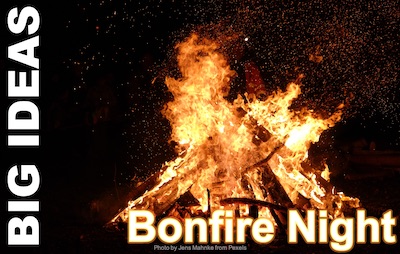
 The lighting of bonfires in the long nights of autumn and winter is a tradition as old as mankind’s occupation of higher latitudes. But Bonfire Night – as the term is used in the UK – has a very specific origin. On 5 November 1605, a group fo Catholic conspirators sought to blow up the Houses of Parliament, while the Protestant king, James I of England and VI of Scotland, was to be there with his family. One conspirator, Guy Fawkes, was found in the cellars with 36 barrels of gunpowder.
The lighting of bonfires in the long nights of autumn and winter is a tradition as old as mankind’s occupation of higher latitudes. But Bonfire Night – as the term is used in the UK – has a very specific origin. On 5 November 1605, a group fo Catholic conspirators sought to blow up the Houses of Parliament, while the Protestant king, James I of England and VI of Scotland, was to be there with his family. One conspirator, Guy Fawkes, was found in the cellars with 36 barrels of gunpowder.
From that year, the failure of the Gunpowder Plot, as it was known, has been celebrated in Britain – and also in many Commonwealth countries. Since the 1606 law, the ‘Observance of 5th November Act’, commonly called the ‘Thanksgiving Act’, Bonfire Night has been on 5th November. It’s also sometimes called Guy Fawkes’ Night, because it is also a tradition to burn an effigy of the hapless engineer on top of the bonfire; the ‘Guy’ as he is known.
That ‘Guy’ is something of an ‘evil everyman’. It’s now a tradition in some places to replace Fawkes with an effigy of a newsworthy figure of hate or ridicule. This can sometimes give offence. But in Britain, the right to give offence – particularly to politicians and public figures – has long been cherished. Bonfire Night is a good outlet for this spirit.
Why did Fawkes and his Co-conspirators seek to Blow-up Parliament and the King?
That’s a big question and I’m no more than an amateur historian. The story is something of a ripping yarn and has been written up in factual and semi-fictional versions many times, and has been filmed often too. In essence, though…
Sectarianism
Queen Elizabeth I was a ‘good queen’. But she made enemies as a Protestant who defied Catholic Spain. Although her domestic policies were far less repressive than her Catholic sister, Mary’s, or her Protestant brother, Edward’s, her advisors did see Catholics as a pool for domestic terror. Elizabeth died in 1603, having executed her Catholic rival claimant to the throne, Mary Queen of Scotland. But English Catholics hoped that her successor, Mary’s son, James, would be more tolerant of their Catholicism, despite being Protestant himself.
It was not to be. So, 13 young gentlemen and noblemen decided to extract retribution on James. They were led by Robert Catesby, who argued for violent action. Gradually, they hatched a plan to blow up the Houses of Parliament, while the King and his family were there.
Failure
To cut a long (and exciting story) short, the plan almost succeeded. It was waylaid when one conspirator wrote to warn a relative who was due to accompany the king in Parliament. But, on receiving this letter, Lord Monteagle sped to Whitehall, to warn the King’s Secretary of State, Robert Cecil. The plot was busted.
It was still touch and go, whether it would be foiled, though. But, foiled it was; when the Government’s men found the cache of gunpowder and the conspirator, Fawkes.
What happens on Bonfire Night?
Many families hold their own celebration, in a garden, with a bonfire and, often, fireworks.
In many places, there are community or municipal events, often in parks and on recreation grounds. These are usually organised by local community associations, who charge for attendance to raise money for charities.
In a number of towns in Sussex (and a small number in Kent and Surrey), Bonfire Night is a huge event. There, local Bonfire Societies compete to put on the grandest torchlight procession, biggest bonfire, and most splendid fireworks display. Torches, sparklers, glowsticks, and food are all on sale – often to raise money to fund the societies.
Bonfire Night: A Good Thing?
This will divide people.
Pros
On the one hand, Bonfire Night is a welcome community event, in the long haul between summer and mid-winter. In the UK, it still wins out over Hallowe’en. But that is, sadly, changing. US Hallowe’en culture is growing here. It can lift spirits, entertain, bring people together, and raise money for worthy causes. It certainly does, here in New Alresford, where Management Pocketbooks is based (thank you Alresford Rotary).
Cons
On the other hand, stray fireworks and poor safety practices can mean a massive uptick in calls to the fire brigades, and admissions to Accident and Emergency units in hospitals. And, the burning of so much processed wood on one night has a measurable impact on air quality and pollutants (as well as releasing tonnes of Carbon Dioxide).
For most of us, though, the answer is an emotional one: we either like the spectacle or we don’t.
What is Your experience of Bonfire Night?
We’d love to hear your experiences, ideas, and questions. Please leave them in the comments below.
To learn more…
The Bonfire Night Pocketbook is… not yet scheduled.
